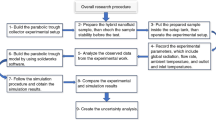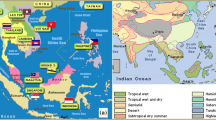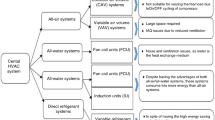Abstract
In this study, passive cooling of a room using a solar chimney and water spraying system in the room inlet vents is simulated numerically in Yazd, Iran (a hot and arid city with very high solar radiation). The performance of this system has been investigated for the warmest day of the year (5 August) which depends on the variation of some parameters such as water flow rate, solar heat flux, and inlet air temperature. In order to get the best performance of the system for maximum air change and also absorb the highest solar heat flux by the absorber in the warmest time of the day, different directions (West, East, North and South) have been studied and the West direction has been selected as the best direction. The minimum amount of water used in spraying system to set the inside air averaged relative humidity <65 % is obtained using trial and error method. The simulation results show that this proposed system decreases the averaged air temperature in the middle of the room by 9–14 °C and increases the room relative humidity about 28–45 %.


















Similar content being viewed by others
Abbreviations
- ACH :
-
Air change per hour (h−1)
- C p :
-
Specific heat of air at constant pressure (J/kg K)
- D H2O :
-
Diffusion coefficient of water vapor into air (m2/s)
- E :
-
Energy term (J)
- G sc :
-
Solar constant (W/m2)
- I :
-
Hourly radiation (MJ/m2 h)
- J j :
-
Diffusion flux of species j
- K T :
-
Hourly clearness index
- \(\overline{K}_{T}\) :
-
Monthly average clearness
- P :
-
Static pressure (Pa)
- Pr t :
-
Prandtl number
- R b :
-
Ratio of beam radiation on the tilted surface to that on horizontal surface
- S H2O :
-
Water vapor added to or removed from the air (kg/s m2)
- Sc t :
-
Turbulent Schmidt number
- S m :
-
Mass source term (kg/s m3)
- T :
-
Temperature (K)
- X, Y, Z :
-
Coordinate system
- d :
-
Chimney width (m)
- f i :
-
External body force in ith direction (N/m3)
- h :
-
Sensible enthalpy (J/kg)
- i :
-
Daily hour (h)
- n :
-
Number of days
- t :
-
Solar time (h)
- u :
-
Direction velocity (m/s)
- δ :
-
Declination
- β :
-
Slope
- ρ :
-
Density (kg/m3)
- ρ g :
-
Reflection coefficient of surrounding ground
- φ :
-
Latitude
- ω :
-
Hour angle
- ω s :
-
Sunset hour angle
- μ :
-
Dynamic viscosity (Pa s)
- μ t :
-
Turbulent viscosity (Pa s)
- θ :
-
Inclination angle measured from the horizontal plane (deg)
- θ′:
-
Angle of incidence
- θ ′ z :
-
Zenith angle
- T :
-
Tilted surface
- a :
-
Absorber
- b :
-
Beam
- d :
-
Diffuse
- g :
-
Glass
- h :
-
Horizontal surface
- m :
-
Maximum
- n :
-
Minimum
- oh :
-
Extraterrestrial radiation on a horizontal surface for an hour period
- w :
-
Wall
References
Kalantar V (2009) Numerical simulation of cooling performance of wind tower (Baud-Geer) in hot and arid region. Renew Energy 34:246–254
Bahadori MN (1985) An improved design of wind towers for natural ventilation and passive cooling. Sol Energy 35:119–129
Yaghoubi MA, Sabzevari A, Golneshan AA (1991) Wind towers: measurement and performance. Sol Energy 47:97–106
Saffari H, Hosseinnia SM (2009) Two-phase Euler–Lagrange CFD simulation of evaporative cooling in a wind tower. Energy Build 41:991–1000
Miyazaki T, Akisawa A, Kashiwagi T (2006) The effects of solar chimneys on thermal load mitigation of office buildings under the Japanese climate. Renew Energy 3:987–1010
Amer EH (2006) Passive options for solar cooling of buildings in arid areas. Energy 31:1332–1344
Bassiouny R, Koura NSA (2008) An analytical and numerical study of solar chimney use for room natural ventilation. Energy Build 40:865–873
Afonso C, Oliveira A (2000) Solar chimneys: simulation and experiment. Energy Build 32:71–79
Mathur J, Bansal NK, Mathur S, Jain M, Anupma (2006) Experimental investigations on solar chimney for room ventilation. Sol Energy 80:927–935
Bansal NK, Mathur J, Mathur S, Jain M (2005) Modeling of window-sized solar chimneys for ventilation. Build Environ 40:1302–1308
Bassiouny R, Koura NSA (2009) Effect of solar chimney inclination angle on space flow pattern and ventilation rate. Energy Build 41:190–196
Maerefat M, Haghighi AP (2010) Natural cooling of stand-alone houses using solar chimney and evaporative cooling cavity. Renew Energy 35:2040–2052
Miyazaki T, Akisawa A, Nikai I (2011) The cooling performance of a building integrated evaporative cooling system driven by solar energy. Energy Build 43:2211–2218
Chungloo S, Limmeechokchai B (2007) Application of passive cooling systems in the hot and humid climate: the case study of solar chimney and wetted roof in Thailand. Build Environ 42:3341–3351
Chungloo S, Limmeechokchai B (2009) Utilization of cool ceiling with roof solar chimney in Thailand: the experimental and numerical analysis. Renew Energy 34:623–633
He J, Okumura A, Hoyano A, Asano K (2001) A solar cooling project for hot and humid climates. Sol Energy 71:135–145
Bahadori MN, Chamberlain MJ (1986) Simplification of weather data to evaluate daily and monthly energy needs of residential buildings. Sol Energy 36:499–507
Duffie JA, Beckman WA (2013) Solar Engineering of Thermal Processes, 4th edn. Wiley, USA
Bahadori MN, Mirhosseini S (2005) Sky clearness index for Iranian cities. Orlando, FL, USA, Solar World Congress, Paper No. 1120 ISES
Wilcox DC (1994) Turbulent Modeling for CFD, 2nd edn. DCW Industries, California
Mathur J, Mathur S, Anupma (2006) Summer-performance of inclined roof solar chimney for natural ventilation. Energy Build 38:1156–1163
Author information
Authors and Affiliations
Corresponding author
Appendix
Appendix
The details and parameters needed for simulation of the water spraying system in FLUENT software follow as:
-
(a) The “Species Transport Model” should be selected.
-
Define > Models > Species > Transport & Reaction > Species Transport
-
(b) Based on the number of inlet vents, the number of injections should be selected
-
Define > Injections > Create Injections > Set Injection properties
Set Injection properties for present study | |
Injection type | Surface |
particle type | Droplet |
Material | Water-Liquid |
Diameter distribution | Uniform |
Evaporating species | H2O |
Furthermore, regarding the problem conditions, the “Point Properties” that includes diameter, temperature, velocity magnitude, and total flow rate are defined.
Rights and permissions
About this article
Cite this article
Rabani, R., Faghih, A.K., Rabani, M. et al. Numerical simulation of an innovated building cooling system with combination of solar chimney and water spraying system. Heat Mass Transfer 50, 1609–1625 (2014). https://doi.org/10.1007/s00231-014-1366-5
Received:
Accepted:
Published:
Issue Date:
DOI: https://doi.org/10.1007/s00231-014-1366-5




